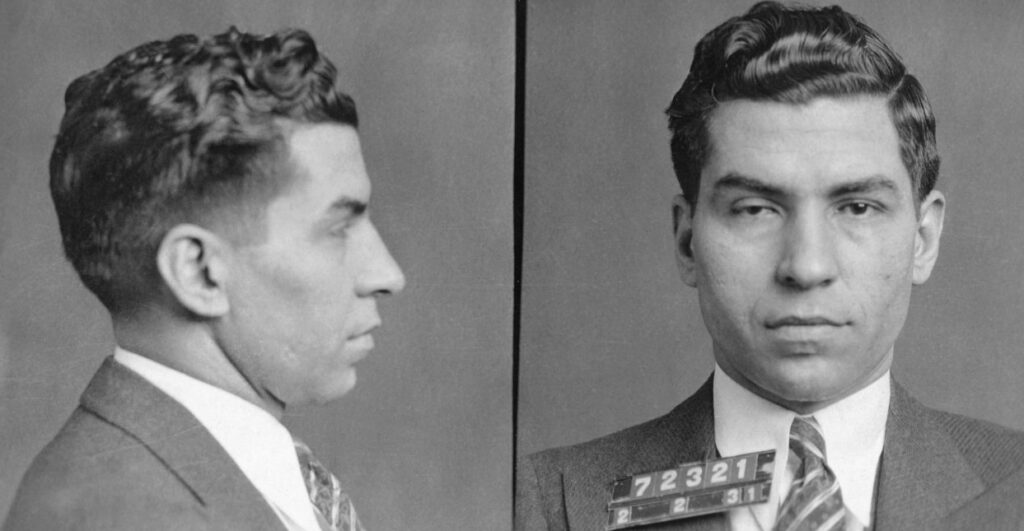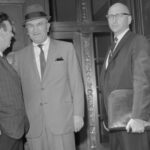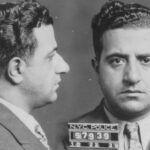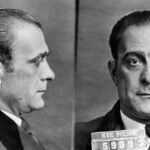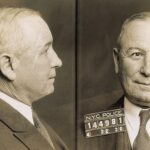Early Life – From Sicilian Immigrant to New York Streetwise
Born Salvatore Lucania on November 24, 1897, in Lercara Friddi, Sicily, Lucky Luciano was destined to become one of the most formidable figures in American organized crime. His family migrated to the United States in 1906, settling in the Lower East Side of Manhattan—a hotbed of Italian immigration. Luciano’s early years in America were far from easy. Struggling with language barriers and poverty, he dropped out of school and took a job as a hat purveyor, earning a meager weekly wage. However, the streets of New York offered him a different kind of education—one that would shape his future in unimaginable ways.
The Formation of Alliances – Meyer Lansky and Bugsy Siegel
In the gritty streets of New York’s Lower East Side, a young Luciano found more than just a playground; he found a training ground for his future empire. The neighborhood was a crucible where alliances were forged, and it was here that Luciano met Meyer Lansky and Benjamin “Bugsy” Siegel. These weren’t casual friendships formed over stickball games; these were strategic partnerships that would shape the future of American organized crime.
Luciano’s early venture into extortion was a precursor to the complex criminal operations he would later run. His “protection racket” among schoolmates was a microcosm of the larger schemes he would orchestrate, involving layers of hierarchy and a keen understanding of human psychology. Lansky, with his financial acumen, and Siegel, with his audacity and flair for violence, complemented Luciano’s own strategic brilliance. Together, they formed a triad of criminal expertise that was unparalleled.
Their alliance wasn’t just about pooling resources; it was about diversifying their criminal portfolio. Lansky brought in a mathematical approach to illegal gambling, while Siegel had connections that extended to the West Coast, offering a broader geographical reach for their operations. Luciano, for his part, acted as the linchpin, coordinating these diverse activities into a cohesive operation. This synergy set the stage for their domination of the criminal underworld, making them not just participants but key players in the illicit industries of the time.
Prohibition Era – The Rise of the “Big Six”
The 18th Amendment to the United States Constitution, which led to the prohibition of alcohol, was more than a societal experiment; it was a catalyst for criminal innovation. Luciano and his associates recognized the enormous potential for profit and power in this new landscape. The “Big Six,” a moniker that would become synonymous with bootlegging royalty, didn’t just participate in the illegal liquor trade; they commandeered it.
Luciano’s alliance with Lansky and Siegel was fortified by the addition of Louis “Lepke” Buchalter, Jacob “Gurrah” Shapiro, and Abner “Longy” Zwillman. Each brought a unique skill set and network to the table. Buchalter and Shapiro were labor racketeers who could manipulate unions to facilitate the transport of illegal goods. Zwillman was a political fixer with connections that could provide legal cover for their operations. Together, they formed an intricate web of influence and control that extended from the docks of New York to the speakeasies of Chicago.
Their collaboration with Arnold Rothstein was particularly instrumental. Rothstein wasn’t just another gangster; he was an institution in himself. Known as the Big Bankroll, he was the financial engine that powered many criminal enterprises, including illegal gambling and narcotics trafficking. Rothstein’s mentorship provided Luciano with invaluable insights into the mechanics of large-scale criminal operations. He taught Luciano the art of bribery, the importance of political connections, and the value of public perception. In many ways, Rothstein was the Yoda to Luciano’s Skywalker, guiding him through the complexities of organized crime.
This era wasn’t just about breaking the law; it was about creating a new order within the chaos of Prohibition. The “Big Six” didn’t merely fill a void; they structured it, regulated it, and turned it into a well-oiled machine. Their operations were so expansive and well-coordinated that they effectively became the law within the lawless, setting the standards and practices for organized crime for decades to come.
The Castellammarese War – A Strategic Betrayal
In the volatile landscape of New York’s criminal underworld during the late 1920s and early 1930s, the Castellammarese War was a seismic event that reshaped the Mafia’s power dynamics. Luciano, initially a loyal lieutenant to Giuseppe “Joe the Boss” Masseria, found himself at a crossroads. His loyalty to Masseria was not just a matter of personal allegiance but also a strategic partnership that provided him access to resources and protection. However, Luciano was a man who constantly assessed the chessboard of organized crime, looking for moves that would position him for ultimate control.
Salvatore Maranzano, Masseria’s rival, was not just another ambitious mobster; he was a man who had a different vision for the Mafia—a vision that Luciano found increasingly appealing. Maranzano was a proponent of a more structured, hierarchical organization, inspired by the Roman legions. Luciano saw in Maranzano’s ideas the seeds of modernization that the American Mafia sorely needed.
The decision to betray Masseria was not taken lightly. Luciano knew that switching sides would put him at great personal risk, but the potential rewards were too enticing to ignore. He orchestrated Masseria’s assassination with surgical precision, ensuring that he was not directly implicated but still stood to gain from the power vacuum. The assassination took place at a Coney Island restaurant, a setting chosen for its public visibility, thereby sending a clear message to anyone who might question Luciano’s resolve or capabilities.
When Maranzano declared himself “Boss of Bosses” and initiated the restructuring of the New York Mafia into Five Families, Luciano was appointed the head of one of these families. But this was not just a title; it was a mandate. Luciano was now responsible for modernizing his family’s operations, implementing the structural changes that Maranzano had envisioned, and preparing for the next phase of his own ascension.
The Commission – A New Order in Organized Crime
Luciano’s vision for organized crime extended far beyond the boundaries of a single Mafia family or even the city of New York. He saw the potential for a national syndicate, a coalition of criminal enterprises that could operate with the efficiency and effectiveness of a Fortune 500 company. The Commission was not merely a governing body; it was, in essence, the board of directors for American organized crime.
The inclusion of figures like Al Capone in The Commission was a strategic move designed to consolidate power and neutralize potential threats. Capone, the undisputed king of Chicago’s underworld, had resources and connections that could either bolster or undermine Luciano’s plans. By bringing him into the fold, Luciano ensured that one of the country’s most powerful criminals was an ally rather than an adversary.
The Commission’s role was multifaceted. It served as a conflict resolution mechanism, a regulatory body, and a strategic planning committee. It laid down the rules of engagement for criminal enterprises, arbitrated disputes to prevent internecine warfare, and coordinated large-scale operations such as the fixing of the 1919 World Series. The Commission was also responsible for sanctioning hits, a task that was not taken lightly. A sanctioned hit required a consensus among Commission members, thereby ensuring that violence was used as a last resort and only when absolutely necessary.
Under Luciano’s leadership, The Commission transformed the American Mafia from a collection of warring tribes into a cohesive, well-organized federation. It was a monumental achievement, one that required not just cunning and ruthlessness but also a deep understanding of organizational behavior, human psychology, and strategic planning. Luciano was not just a mob boss; he was a visionary leader who recognized the need for change and had the audacity to implement it.
Legal Troubles and Imprisonment – The Downfall
The year 1936 marked a pivotal moment in Luciano’s life, as his sprawling criminal empire found itself in the crosshairs of Thomas E. Dewey, a prosecutor with political ambitions and a keen eye for high-profile targets. Dewey was not just another legal adversary; he was a man on a mission to clean up New York, and taking down Luciano would be a career-defining achievement. The charges brought against Luciano—compulsory prostitution—were not randomly selected. Dewey chose this angle because it was both morally repugnant to the public and difficult for Luciano to dismiss as mere occupational hazard.
Upon conviction, Luciano was sentenced to 30 to 50 years, a term designed to effectively remove him from the criminal landscape. His initial incarceration at Sing Sing Correctional Facility was a calculated move. Sing Sing was notorious for its harsh conditions and strict oversight, making it difficult for inmates to conduct business from within its walls. However, Luciano was not a man to be easily contained. His subsequent transfer to Clinton Correctional Facility in Dannemora, New York, often referred to as “Little Siberia” due to its remote location and severe conditions, was another attempt to isolate him. Yet, even there, Luciano found ways to communicate with his associates, subtly directing operations and making strategic decisions that affected the Mafia’s day-to-day activities.
The prison years were not merely a hiatus for Luciano; they were a period of adaptation and recalibration. He used this time to rethink his strategies, forge new alliances, and even explore legitimate business ventures that could be pursued upon his release. His influence behind bars was not an act of defiance but a demonstration of resilience, a testament to his ability to adapt to changing circumstances without losing sight of his long-term objectives.
World War II – An Unexpected Alliance
The onset of World War II presented Luciano with an opportunity that was as unexpected as it was fortuitous. The U.S. government, specifically the Office of Naval Intelligence, found itself in a precarious situation. German U-boats were sinking American ships, and there were concerns about sabotage and espionage activities along the Eastern seaboard. Luciano, through his associate Meyer Lansky, offered a solution: naval intelligence and dock security in exchange for a commutation of his sentence.
This was not a simple quid pro quo. Luciano’s offer was a calculated risk that required careful negotiation and planning. He had to convince skeptical government officials of his ability to deliver on his promises while ensuring that his own associates would cooperate without exposing themselves to legal risks. Meyer Lansky served as the intermediary in these negotiations, leveraging his own reputation as a reliable and resourceful operator to vouch for Luciano’s credibility.
The alliance with the U.S. government had far-reaching implications. It not only led to a commutation of Luciano’s sentence but also redefined his relationship with the state. He was no longer just a criminal; he was a man who had provided a service to his country, albeit for personal gain. This transformation had a profound impact on his post-war activities, influencing his deportation to Italy and shaping his subsequent attempts to re-enter the United States.
The deportation in 1946 was not a mere administrative procedure; it was a complex operation that involved multiple government agencies and diplomatic negotiations. Luciano was not sent back to Italy as a defeated criminal but as a man who had struck a deal, a man whose actions had to be carefully managed to avoid political and diplomatic fallout. His deportation set the stage for the next chapter in his life, one that would see him continue to navigate the murky waters of organized crime and geopolitics.
Life in Exile – From Italy to Cuba and Back
The notion of exile often conjures images of isolation and defeat, but for Luciano, it was another arena in which to operate, another challenge to overcome. His initial relocation to Italy was not a retreat but a strategic repositioning. Italy offered Luciano a base from which he could cultivate relationships with European criminal organizations, thereby expanding his influence beyond American shores. However, Italy also presented limitations, including stringent surveillance by Italian authorities and a lack of direct access to his American operations.
Cuba, on the other hand, offered a tantalizing alternative. Just 90 miles from the coast of Florida, Cuba was a geopolitical and criminal nexus that Luciano couldn’t ignore. His move to Cuba was not a whimsical decision but a meticulously planned operation that involved securing safe passage, negotiating with Cuban authorities, and setting up a new base of operations. The Havana Conference of 1946 was not just another meeting; it was a summit that had the potential to redefine organized crime on a global scale. Luciano saw Cuba as a springboard for international criminal enterprises, from drug trafficking to illegal gambling.
However, Luciano’s Cuban ambitions were thwarted by external pressures, most notably from the U.S. government. His presence in Cuba became a diplomatic issue, a point of contention between the U.S. and Cuban governments. The American authorities leveraged their influence to force Luciano’s expulsion, effectively curtailing his plans for a Pan-American criminal syndicate. His forced return to Italy was not just a logistical hurdle; it was a political maneuver orchestrated at the highest levels of the U.S. government. Back in Italy, Luciano found himself under even tighter surveillance, a marked man whose every move was monitored by law enforcement agencies both domestic and foreign.
Personal Life – Love and Loss
The narrative of Luciano’s life is often dominated by his criminal exploits, overshadowing the human dimensions that add complexity to his character. His relationship with Igea Lissoni, an Italian ballerina, offers a window into Luciano’s private life, revealing a man capable of love, vulnerability, and, unfortunately, destructive behavior. The 20-year age gap between Luciano and Lissoni was not just a numerical difference; it represented a generational divide, a contrast in life experiences that both enriched and complicated their relationship.
While the nature of their commitment—whether they were officially married or not—remains a subject of debate, what is indisputable is the emotional intensity that marked their time together. Luciano, a man accustomed to control, found himself disarmed by love, yet struggled with fidelity and emotional availability. Lissoni, for her part, had to navigate the complexities of loving a man who was both a public figure and a criminal, a man whose affections were genuine but whose lifestyle posed constant challenges.
The tumultuous nature of their relationship was exacerbated by Luciano’s infidelity and instances of domestic violence, dark aspects that cannot be ignored when assessing their life together. Lissoni’s untimely death from breast cancer in 1959 was not just a personal tragedy for Luciano; it was a moment that forced him to confront his own mortality and the choices he had made. The loss left him emotionally shattered, a man who had faced down law enforcement and rival mobsters but found himself utterly disarmed by grief.
In both his personal and professional life, Luciano was a man of contradictions, a complex figure whose choices and relationships continue to fascinate and perplex those who study him. Whether operating in the criminal underworld or navigating the intricacies of love and loss, Luciano remains an enigmatic figure, a man whose complexities defy easy categorization.
An Unanticipated End
The closing moments of Luciano’s life were as unpredictable as the life he led. On January 26, 1962, Luciano found himself at Naples International Airport, engaged in discussions with a film producer about a biographical film that would immortalize his life and exploits. The irony is palpable: Luciano, a man who had spent a lifetime avoiding the spotlight to conduct his illicit affairs, was now considering a venture that would thrust him into the public eye in perpetuity. But fate had other plans. A fatal heart attack struck him down, abruptly terminating a life that had been anything but ordinary.
The location of his death, Naples International Airport, adds another layer of complexity to Luciano’s final moments. Airports are gateways, transitional spaces that symbolize both arrivals and departures, beginnings and endings. For Luciano, the airport became the backdrop for his ultimate departure, a locale as transient as the life he led. His burial in St. John’s Cemetery in Queens, New York, was more than a geographical relocation of his remains; it was a symbolic return to the city that had been the stage for much of his criminal career. The burial marked the end of an era, but also the beginning of a legacy that would continue to reverberate through the annals of American organized crime.
Lesser-Known Facts About Lucky Luciano: The Man Behind the Myth
The Name “Lucky” – More Than Just a Moniker
The name “Lucky Luciano” wasn’t just a catchy alias; it was an earned title. Luciano survived a kidnapping and brutal beating by rival gang members in 1929, emerging from the ordeal with his life intact. The incident left him with a droopy eye but also solidified his reputation as a man who could survive against the odds. The name “Lucky” became synonymous with his resilience and fortitude, attributes that would serve him well in the perilous world of organized crime.
The Havana Conference – A Global Crime Syndicate
While the Havana Conference of 1946 is well-known for its role in American organized crime, its international implications are often overlooked. Luciano used the conference to establish connections with global criminal enterprises, including drug cartels in South America and black market operators in Europe. The meeting wasn’t just a gathering of American mob bosses; it was a multinational summit that expanded the scope of organized crime beyond U.S. borders.
The Hollywood Connection – Luciano and the Silver Screen
Luciano had a fascination with Hollywood and was friends with several actors and producers. He was particularly close to George Raft, an actor known for his gangster roles in films like “Scarface.” Luciano’s connections in Hollywood were more than just social; they were strategic. He used his influence to gain favorable portrayals of Italians in films, subtly shaping public perception of his community and, by extension, his criminal activities.
The Ship SS Normandie – A Mysterious Fire
In 1942, the luxury ocean liner SS Normandie caught fire and capsized at a Manhattan pier. While the official cause remains unknown, rumors persist that Luciano had a hand in the incident. The ship was being converted into a troopship at the time, and the disaster had a significant impact on the U.S. Navy’s operations. Luciano’s involvement has never been proven, but the incident adds another layer of intrigue to his already complex persona.
The Women in Luciano’s Life – More Than Just Companions
Luciano had several relationships with women throughout his life, but these were not mere dalliances. Women like Gay Orlova, a dancer at the Hollywood Restaurant in New York, provided Luciano with valuable social connections and insights into the upper echelons of society. His relationships were strategic moves, designed to give him access to circles that would otherwise remain closed to a man of his background.
The Kefauver Hearings – A Public Spectacle
In 1951, Luciano was called to testify before the U.S. Senate’s Kefauver Committee, which was investigating organized crime. Although he was in Italy at the time, the hearings were a media sensation, and Luciano’s testimony was highly anticipated. However, he refused to answer most questions, invoking the Fifth Amendment. While he revealed little, his mere presence added a layer of drama and urgency to the proceedings, underscoring the government’s inability to fully contain him even in exile.
The Luciano Family Today – A Lasting Legacy
While Luciano himself had no children, his extended family continues to live in the United States and Italy. They have largely stayed out of the public eye, avoiding the notoriety that comes with the Luciano name. Yet, they serve as a living testament to the man who once stood at the helm of American organized crime, a silent reminder of a legacy that refuses to fade away.
Legacy – The Genovese Crime Family and Beyond
The notion that a man’s legacy is defined by what he leaves behind is particularly apt in the case of Luciano. His death did not signal the disintegration of the empire he had built; rather, it ushered in a new phase under the stewardship of his former underboss, Vito Genovese. The organization’s transition into what is now known as the Genovese Crime Family was not merely a name change; it was a continuation of the principles and structures that Luciano had instituted. Genovese, a man who had been Luciano’s confidant and right-hand man, was not just a successor but a custodian of Luciano’s vision.
Luciano’s impact on organized crime was not confined to the geographical boundaries of the United States. His methodologies, his organizational structures, and even his ethos found echoes in criminal enterprises worldwide. The international drug trade, illegal gambling rings, and various other forms of organized crime bear the indelible imprint of Luciano’s influence. His strategies for conflict resolution, power consolidation, and business diversification have been studied, adapted, and implemented by criminal organizations across the globe.
Lucky Luciano’s life is a multifaceted narrative that defies simplistic interpretations. He was a Sicilian immigrant who scaled the heights of the American underworld, a criminal mastermind who also had a deeply human side fraught with vulnerabilities and contradictions. His life serves as a lens through which one can examine the darker facets of the American Dream—a dream that promises opportunity but often at a steep moral cost. Luciano’s journey was one of relentless ambition, tactical brilliance, and an unyielding quest for power. Yet, it was also a life marked by personal losses, ethical compromises, and an ever-present tension between his public persona and private self. His story remains an enduring testament to the complexities of human ambition, the moral ambiguities of power, and the intricate web of choices and circumstances that shape our lives.

